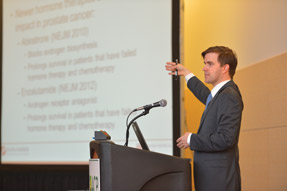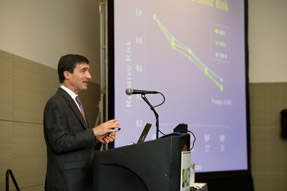Oncologist optimistic about latest cancer treatments
Genomic targeted therapies and immune therapies are 2 areas that internists should know about, so they can refer their patients for such treatments, an expert says.
Oncologist Geoffrey R. Oxnard, MD, is excited about the current state of targeted cancer therapies, the topic of his Internal Medicine Meeting 2015 session, and he wants internists to share his enthusiasm. “Your patients deserve access to this optimism. Don't allow them to be fatalistic and nihilistic,” he said.
Even patients who are sick enough with cancer to be in the ICU can respond dramatically to new targeted treatments if their cancers have the right genetic makeup, according to Dr. Oxnard, a lung cancer specialist and assistant professor of medicine at Harvard Medical School in Boston, who disclosed that he receives consulting fees from pharmaceutical companies.

“It's in the hands of internists and hospitalists” to refer these patients for possible treatment, he said. Current cancer treatment options fall into 3 main categories: chemotherapy, genomic targeted therapies, and immune therapies, all of which will often be given to his patients over the course of their oncology treatment.
The latter 2 categories drive most of Dr. Oxnard's excitement, but even chemotherapy has improved in recent years, especially the experience of it. “Our supportive care is better. Twenty years ago, cisplatin made people miserable,” he said. Today, stronger antinausea medications make it much more tolerable. “It's not fun, but we can do it a lot better than we used to,” Dr. Oxnard said.
Many types of cancer require multiple chemotherapy agents (for example, lung and colon cancer are treated with doublet therapy), so another strategy to reduce side effects is avoiding overlapping toxicities. For example, because cisplatin causes neuropathy, it would be paired with a drug that impairs bone marrow instead of paclitaxel, which also causes neuropathy.
The problem is that experts are not so certain how to pair chemo drugs for the greatest positive effect. “There's not as much science behind how we put these chemos together as you might think,” said Dr. Oxnard. “We sort of make our best guess.” The drugs have been studied in different cancers, but there's no way to test a particular patient's sensitivity to them.
However, with genomic targeted therapy, “I can tell them in advance this is not a guess, this is the right drug for you,” said Dr. Oxnard. Researchers are rapidly discovering new gene mutations responsible for cancer and drugs that effectively combat them.
The hormonal therapies are perhaps the most established targeted therapies, having shown effectiveness in breast, prostate, and endometrial cancer. “These cancers nailed it first, and the rest of us are trying to model the success of hormone therapy,” he said.
One category of drugs working toward that goal is the oral small molecule inhibitors, which block specific cellular pathways. They are known as the “-ibs”: erlotinib for lung cancer, vemurafenib for melanoma, and lapatinib for breast cancer, among others. “You will see these drugs emerge on your patients' lists of medicines,” Dr. Oxnard told the internists.
The drugs are prescribed to patients found to have a specific genotype of cancer, the list of which is ever growing. For example, in 2004, only 2 genotypes of lung cancer were known (EGFR and KRAS), but by 2012, there were 9.
Newly discovered genotypes tend to be rarer than the longstanding ones, but given the prevalence of cancer and the high response rates to the targeted drugs (“Smart drugs should have a 70% to 80% response rate,” Dr. Oxnard noted), even the discovery of a fairly rare mutation can have a significant impact for patients.
As an example, he asked the audience how many of them had ever seen a patient with mesothelioma and how many had seen a patient with ROS-1 rearranged lung cancer. A significant portion raised their hands for the former and none for the latter. The prevalence of these cancers is actually the same, Dr. Oxnard noted. “You haven't seen it because you haven't been looking,” he said.
It's little wonder that internists haven't known to look for this particular cancer type, since the array of drugs and mutations is growing all the time. “It is happening out there and I can barely keep up with all the New England Journal papers,” said Dr. Oxnard.
Researchers are also working to make the smart drugs smarter, so that they target a cancer very narrowly and cause fewer collateral side effects to the patient's body. The downside is that these drugs will have a narrower application, too. “Drug companies don't always like this as much; they want to hit a lot of targets to sell a lot of drugs,” said Dr. Oxnard.
Monoclonal antibodies (the “-abs”) are another category of targeted therapy, although they are not yet as smart as experts would like. For example, there isn't a test to determine definitively whether a patient will respond to bevacizumab. To improve these medications, researchers are now working on linking them to a toxin, to create an antibody-drug conjugate that will more potently attack cancer.
Speaking of antibodies, immune therapies have shown recent promise after many decades of failure. Research in this area began with allogeneic stem-cell transplantation, still the standard for adult leukemia. Now researchers are attempting to train the immune system, rather than replace it. “Can we convince the immune system to do its job and attack the cancer?” asked Dr. Oxnard.
One potential answer is adoptive T-cell therapies. “Draw patients' blood, get out their immune systems, and then take their immune cells and rev them up ... Then pour them back in the patient and say, ‘Go,’” he explained. The problem is that some patients benefit, but others suffer serious immune side effects. “This is going to be so cool if we can pull it off, but we need to find a way to do it without causing undue toxicity and off-target effects,” said Dr. Oxnard.
Researchers are finding more success recently with the latest immune therapy strategy, disinhibiting the immune system. These new therapies (which include ipilimumab, pembrolizumab, and nivolumab) can have dramatic effects for some patients, according to Dr. Oxnard. “You can have an immune system that wakes up, makes the cancer melt away, and keeps it like that,” he said. “We may be able to turn stage IV cancer into cures with these drugs.”
Not every patient responds, however, and researchers haven't yet identified biomarkers that will very accurately predict who will benefit from the new immune therapies, Dr. Oxnard noted. On the positive side, there are few side effects, although rare patients develop autoimmune disease. The drugs are also very expensive, he acknowledged.
Palliative care, on the other hand, is an important component of cancer care that doesn't cost a lot. Dr. Oxnard pointed to recent research finding that cancer patients referred to palliative care actually lived longer. “Patients who take care of themselves and take care of their symptoms do better,” he said. He added that he doesn't refer all of his patients to palliative care, but he does give them 3 rules for living with lung cancer.
First, “Don't act sick.” Being active helps patients maintain strength and function, he noted. The second rule is not to lose weight; the best diet for patients with metastatic cancer may be junk food, Dr. Oxnard said, only half-jokingly. “When you have a 10-pound cushion that allows you to get hospitalized for pneumonia and not die, then you can eat broccoli,” he added. The final rule is, “Don't be a tough guy.” Cancer patients should be encouraged to report all their concerns and symptoms. “Stoicism is one problem that makes our patients unable to capitalize on these therapies,” Dr. Oxnard said.
Patients will also miss out on the innovative therapies if they aren't seen by an oncologist who uses them. Dr. Oxnard closed his lecture by urging internists to encourage their patients who have cancer to seek second opinions and look into treatment at an academic center.




